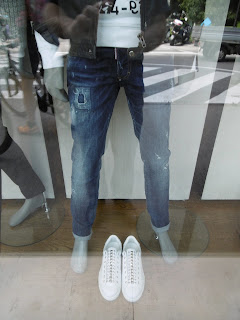Saw the Bruges triptich of 'The Last Judgement' today, one of two versions
attributed to Hieronymous Bosch (the other is in Vienna). The newly
restored painting in oil on oak panels is currently on display at Arentshuis Museum. The transition from heaven to hell via the middle panel over which Christ sits in judgement flanked by trumpeting angels seems to be as much about a change in weather and atmosphere as a judgment between good and evil. From left to right there is a transition from pale blue sky through grey clouds to a darker and more noxious red and black smoke filled hell of cities burning on the horizon. In the middle and foreground is a watery grey and brown terrain in which half human/half animal creatures cavort and play or submit to extraordinarily ingenious tortures. Both the anonymous naked and the more identifiable clothed people, including bishops, friars and nuns, inhabit a sinful world in which the ordinary paraphernalia of everyday life like a knife, a funnel, a slipper, etc., are transformed into a rooftop, a sailing ship and other whimsical contraptions.
 | |||||||||||||||||||||||||||||||||||
| Hieronymous Bosch, Last Judgement, 1480 or later, oil on panel, Groeninge Museum, Bruges. |
If Bosch's atmospheric sky is an expression of the opposition between good and evil and heaven and hell then it might fit the thesis of Alexandra Harris' book 'Weatherland' which charts our inner and outer physical
and emotional weather through art and literature under 'English' skies.
Reading it I couldn't help thinking that the weather, rather like the
art and literature, has a tendency to cross national borders, a fact
born out by the influence of Claude on Turner or Dutch landscape artists
like Van Ruisdael on Constable. Perhaps English skies are in fact more
European than some would care to admit and the weather a more connected
global phenomenon that we sometimes make it in our local and perhaps
parochial way.
The politics of the 15th and 16th century Netherlands were certainly as confusing and conflicted as our present day media driven 'post truth' politics and the world as uncertain, unstable, disillusioning and apocalyptic as Bosch's ordered vision of disorder suggests. Its hard not to be cynical about the motives behind the lust for power, material gain and pleasure when they are pursued by pious hypocrites but then who is not deluded by the same kind of folly in one form or another? In 'Figures of Speech. Picturing Proverbs in Renaissance Netherlands' Walter S Gibson analyses the meaning of another painting by Bosch, his 'Haywain'.
'Bosch thus employed hay as the most fitting symbol of the intrinsic worthlessness of all temporal possessions, honors, and pleasures, especially when measured against the spiritual "goods" that the blessed souls will enjoy after death.'
 |
| Hieronymous Bosch, Haywain, oil on panel, Madrid, Museo del Prado. |
'... The haywain shows how the transitory goods and honors of this world are greedily sought after by rich and poor alike, and not only laypeople but those in religious orders as well...... In the immediate foreground of the haywain Bosch.. shows us various species of avarice. This the man wearing a tall hat and accompanied by a child at the lower left may well be a false beggar, one who does not need to beg. Nearby another man has set up a table with jars, charts,and other paraphernalia of the itinerant quack, his hay stuffed purse testifying all too clearly his success with the gullible.'
George Orwell's book '1984' and the current adaptation for the stage which we saw at the London Playhouse Theatre last month presents a vision of a particularly modern kind of totalitarian hell, one in which Newspeak has corrupted and devalued language, 'Big Brother' is always watching you and 'thought police' are everywhere, especially through the 'telescreen' and anyone guilty of thought crime ends up being tortured in room 101 and all trace of them eliminated by The Ministry of 'Truth'.
Coming out of the Playhouse Theatre with the art trip students a few weeks ago the play seemed as relevant to the present times as the book was when it was when it was first published in 1949. We might say the same about Bosch.

























































